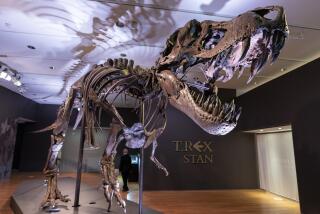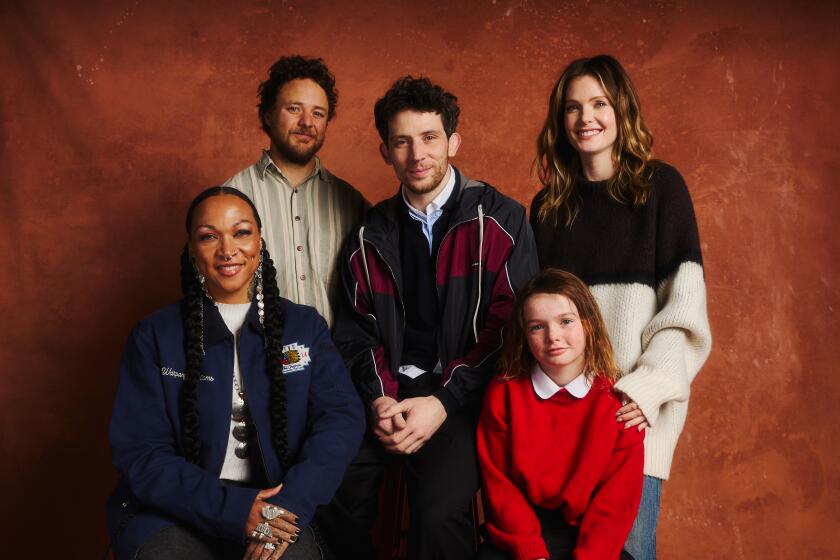A look inside Hollywood and the movies : Dinologists Aren’t Saur, but ‘Jurassic Park’ Gets DNA Docs’ Amber Up
- Share via
Scientists who have seen the blockbuster movie “Jurassic Park” say that director Steven Spielberg got the science half right. The dinosaurs look and act the way most paleontologists now think their real-life counterparts did, but the genetic engineering that produced the dinosaurs is improbable if not flat-out impossible, according to molecular biologists.
“ ‘Jurassic Park’ is a triumph from a paleontologist’s point of view,” said Kevin Padian of UC Berkeley. “These are clearly the ‘new look’ dinosaurs that research of the past two decades has described, and it’s high time they were on the screen.”
“By and large, they did a damned good job,” added paleontologist Kenneth Carpenter of the Denver Museum of Natural History. “The power of T. rex really comes through in the movie. He really lives up to his name. I just hope that all the inevitable clones will be as good.”
Despite their high praise and fondness for the movie--most have seen it multiple times and have required their students to see it as well--the dinosaur collectors did have a few minor quibbles.
The head of the brachiosaurus that nibbled on plants high up in the trees “was about three times larger than an actual head would be, according to the fossils,” said paleontologist Mark Norell of the American Museum of Natural History in New York City, where many of the dinosaurs used in the film will be displayed next month. The velociraptor that stalks the children through the kitchen is also two to four times larger than velociraptors actually were, researchers said. “But while they were filming the movie, there has been a new creature discovered in Utah, named Utahraptor, that appears to have been about the same size as those in the movie,” said Carpenter.
The most inaccurate depiction was of the dilophosaurus, the small dinosaur with the flaring collar who spits venom. Dilophosaurus was actually much bigger than this, about 20 feet long, and there is no evidence that it had a flared collar or spit venom. “The idea for this came from one scientist’s suggestion that the gap between two of the tooth-bearing bones in the real dilophosaurs might have held a venom canal. . . . However, it turns out to be just a gap.”
The dinosaurs’ behavior was also realistic, experts agreed, but “they were a little bit too mammalian in their cunning,” said paleontologist Michael Brett-Surman of the Smithsonian Institution in Washington. “The meat-eaters were definitely more intelligent than the plant-eaters and were probably the most intelligent animals on Earth then. But their cunning and learning how to open doors within seconds of encountering them is a mammalian trait that you would not expect from a reptile or a bird.”
Finally, the ability of T. rex to see prey only when it was moving is almost certainly incorrect. Dinosaurs, like all reptiles and birds, had “lousy senses of smell” as indicated by the small olfactory lobes of the brain, Padian said. “But they had excellent sight and most probably had color vision.
“Any self-respecting carnivore is also a scavenger,” Padian said, “but if you can’t smell a carcass and if you can’t spot it because it is not moving, you’re going to go hungry.”
Molecular biologists, however, are much less happy with the movie and the book it was based upon. Its author, Michael Crichton, “is incredibly hostile to science,” said molecular geneticist Leroy Hood of the University of Washington School of Medicine. Hood believes Crichton’s position is that “much genetic engineering is thoughtless or frivolous, that the work is uncontrolled, and that it is done in secret, in haste and for profit. That’s simply not correct.”
Furthermore, the science described is virtually impossible. “Isolating DNA and making dinosaurs is not going to happen,” said molecular biologist Raul Cano of Cal Poly San Luis Obispo, who himself works with DNA--deoxyribonucleic acid, the genetic blueprint of life--isolated from amber.
The problems are innumerable. First, scientists cannot yet clone an animal from DNA, although that technology should be available. Second, human DNA contains 3 billion individual chemicals arrayed in precise order and a mistake in even one of them can be lethal. Dinosaurs would have at least that much DNA.
Third, even though insects are well preserved in animals, their DNA is not. It is highly fragmented and large amounts are missing: Geneticists are lucky if they can fish out one gene from it, much less the 100,000 or so genes necessary to produce a living being. And DNA in an insect’s stomach is going to be even more fragmented.
“It (making a dinosaur) would be like trying to rewrite Tolstoy’s ‘War and Peace’ based on a gigantic pot of alphabet soup,” said molecular biologist David Grimaldi of the American Museum of Natural History.
More to Read
Only good movies
Get the Indie Focus newsletter, Mark Olsen's weekly guide to the world of cinema.
You may occasionally receive promotional content from the Los Angeles Times.










